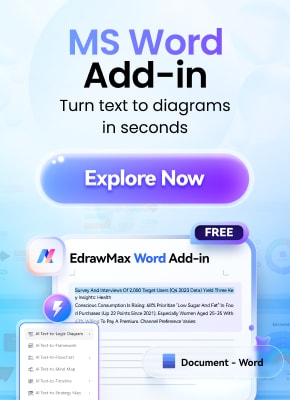Every tool tells a story. After the Bronze Age, bronze tools became too costly, and tin was rare. Iron was stronger and more common but harder to shape. So, by 1200 BCE, ironworking began. People started mastering it, and it gradually replaced bronze.
Around 700 BCE, iron was widespread across Europe and the Middle East. Farmers worked smarter, soldiers fought better, and builders created stronger structures. Iron wasn’t shiny like bronze but was more durable and reliable. This Iron Age timeline tells the story of iron’s rise and how it shaped history. Sit back, relax, and enjoy the Iron's Age story!
Iron Age Timeline
The Iron Age began around 1200 BCE and followed the end of the Bronze Age. It was a turning point in history. People discovered that iron could replace bronze for tools and weapons. It was tougher, more affordable, and much easier to find.
As this new metal spread, life began to change. Farming got better, battles became more intense, and civilizations started to grow stronger. This was the start of a brand-new chapter for humanity. Let’s see how this simple metal turned the ancient world upside down.
1380 BCE: Hittite Ironworking Begins
In Anatolia, the Hittites started experimenting with iron, marking the earliest known steps into the Iron Age. At this stage, iron was rare and valued as highly as gold today. It appeared mainly in weapons, tools, and ceremonial items.
Hittite blacksmiths kept their methods secret, guarding their knowledge from outsiders. Even though it wasn’t widely used yet, their work laid the foundation. Over time, the skills they developed spread beyond their borders, starting iron’s slow takeover from bronze.
1200 BCE: The Bronze Age Collapse, Iron Rises
Great empires crumbled, trade routes broke, and cities burned. The sudden shortage of tin made bronze harder to produce, leaving people searching for alternatives. Iron, though harder to work, became the practical choice.
This was not a planned shift, it was survival. As chaos spread, iron moved from a rare luxury to a common necessity. People adapted quickly, and in doing so, unknowingly began a new era: the Iron Age, born from crisis rather than celebration.
1100 - 600 BCE: Greece’s Dark Age and Iron’s Role in Recovery
After the collapse, Greece entered what historians call its “Dark Age.” It was a challenging time, yet iron tools became vital for farming and rebuilding communities. Farmers plowed better fields, and warriors carried stronger weapons.
By around 800 BCE, Athens began to grow again. Public spaces like the Agora appeared, and life slowly improved. Iron helped Greece defend itself, farm more efficiently, and take the first steps toward a new age of cultural growth.
1000 BCE: Ironworking Spreads to Southern Europe
Ironworking techniques reached southern Europe around this time. Local blacksmiths quickly learned the craft, producing sickles, hoes, and simple weapons for everyday use. These tools helped villages become more self-reliant.
Iron wasn’t just about warfare, it improved farming, construction, and trade. With each passing year, communities became stronger and better equipped to handle challenges. The spread of iron in southern Europe marked a steady rise in both skill and independence for its people.
800 - 600 BCE: Peak of Hallstatt Culture
In central Europe, the Hallstatt culture pushed ironworking to new heights. Known for fine swords, tools, and ornaments, they combined strength with craftsmanship. Their leaders were buried with iron weapons and treasures of gold.
Salt mining brought them wealth, but iron brought them power. Their traditions influenced early Celtic culture, and their iron tools and weapons spread across Europe. The Hallstatt people didn’t just survive, they thrived with iron at the core of their society.
750 BCE: Iron Arrives in Ancient Egypt
Egypt began using iron around 750 BCE. At first, it was rare, reserved for the elite, and bronze was still common. But the advantages of iron quickly became clear.
Blacksmiths adapted their old skills to this new metal, crafting stronger tools and weapons. Although Egypt didn’t lead the iron revolution, it embraced it steadily. Over time, iron quietly reshaped Egyptian farming, trade, and warfare from the ground up.
700 BCE: Iron Age Begins in Scotland
Scotland entered its Iron Age when communities shifted from stone and bronze tools to iron. Hillforts were built for defense, and iron swords and plows became essential for daily life.
This change brought sharper tools, stronger homes, and more organized warfare. Communities grew closer and more capable of protecting themselves. Iron gave the Scots better control over their land, crops, and conflicts, marking a major step in their development.
700 BCE: Iron in Wide Use Across Europe
Around this time, iron was no longer rare, it was a daily necessity. Farmers used it for plows, warriors for weapons, and builders for stronger homes.
The transformation was gradual but powerful. Iron allowed people to cultivate more land, store more food, and build safer shelters. Across Europe, it became the silent force driving progress, improving lives in ways that bronze never could.
650 BCE: Iron Spreads to North Africa
Iron reached North Africa through trade and necessity. Cities like Carthage quickly adopted it for farming tools, weapons, and everyday items. Blacksmiths adjusted their skills to match the demands of this tougher metal.
The impact was immediate, agriculture improved, defenses strengthened, and communities expanded. Iron became more than a material; it became a foundation for growth, supporting life from simple villages to bustling trade hubs.
200 BCE: Iron Dominates in the Celtic World
By 200 BCE, iron was everywhere in the Celtic world. It was no longer new, it was essential. Farmers relied on it, warriors wielded it, and households used it daily for cooking and work.
Skilled blacksmiths held high status, shaping both practical tools and symbols of power. Iron wasn’t just a metal; it represented progress, pride, and identity. It connected the Celtic people through shared technology and a stronger way of life.
How to Make an Iron Age Timeline Using EdrawMax
The Iron Age was when people started using iron tools and weapons, changing history forever. Creating a timeline is a great way to display important events and cultures from this era in a clear, organized way.
If you’re new to diagramming, EdrawMax makes it simple to create professional timelines quickly. It offers plenty of templates and easy-to-use tools perfect for beginners.
Here’s how to create your Iron Age timeline with EdrawMax:
Step1Open a Blank Workspace
- Open EdrawMax on your computer, and sign in (or create an account if you’re new).
- Click New on the left panel.
- Choose Blank Drawing to start with a clean canvas for the Iron Age timeline.
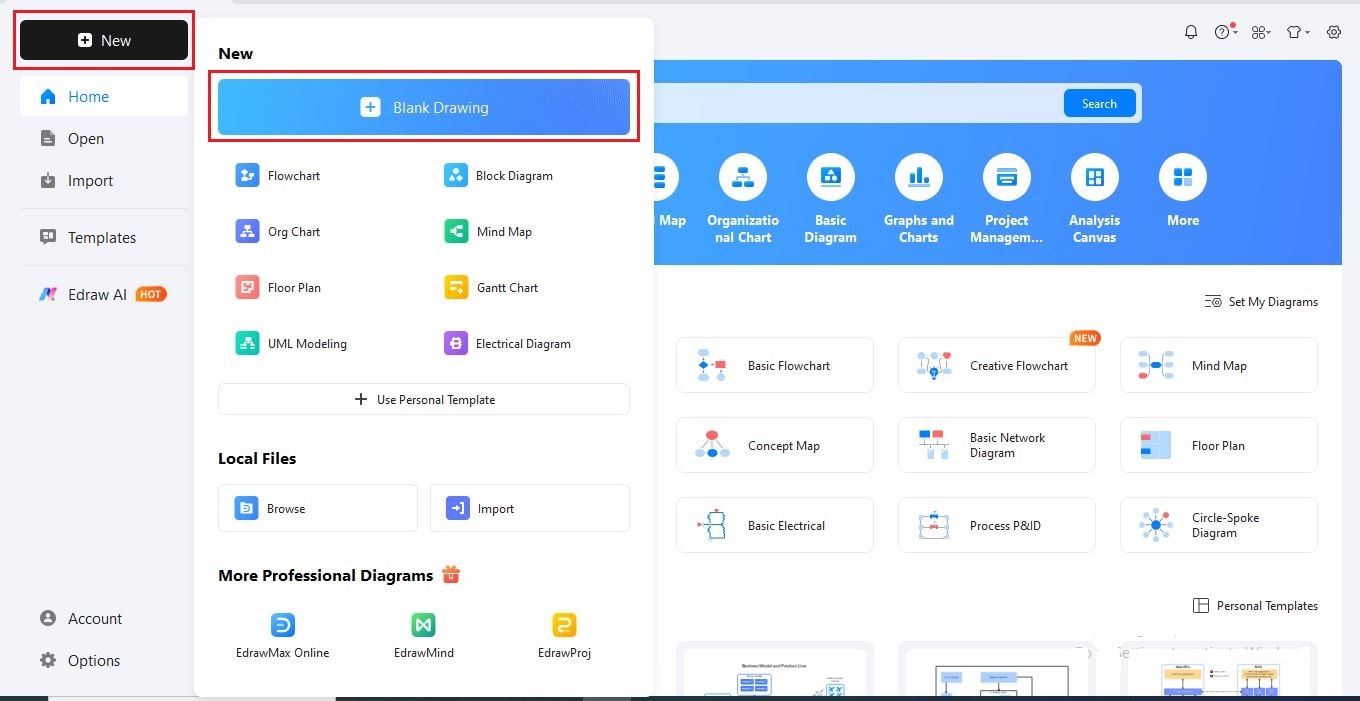
Step2Add a Background Image
- Set a fitting backdrop to give the timeline a historical feel.
- Go to the Insert tab in the top toolbar.
- Select Picture > Local Pictures and upload a background image.
- On the floating toolbar click Adjust to customize transparency, and lock it with Move to Layer so it stays in place.
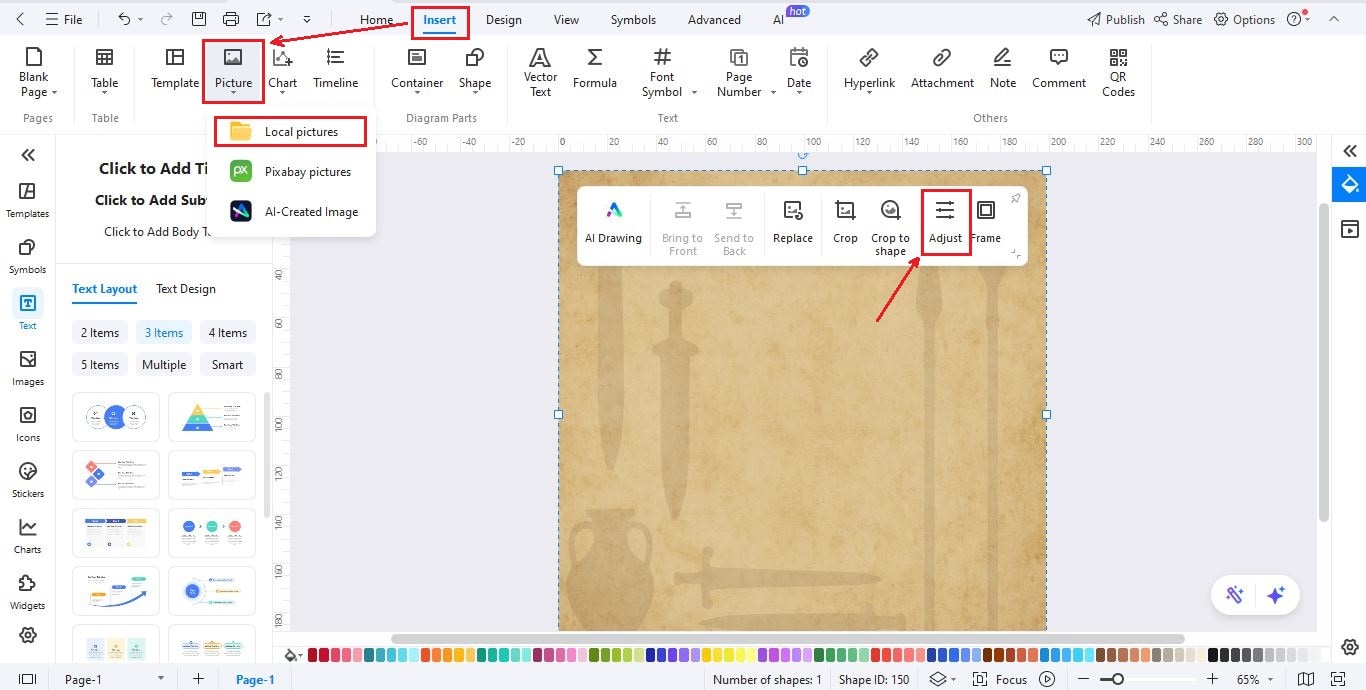
Step3Add a Title for the Timeline
- Give your timeline a clear and bold heading.
- You can add text or upload a title image. Go to Insert > Picture > Local Pictures and upload a styled title graphic.
- Optionally, enhance it with symbols like iron weapons, shields, or ancient patterns.
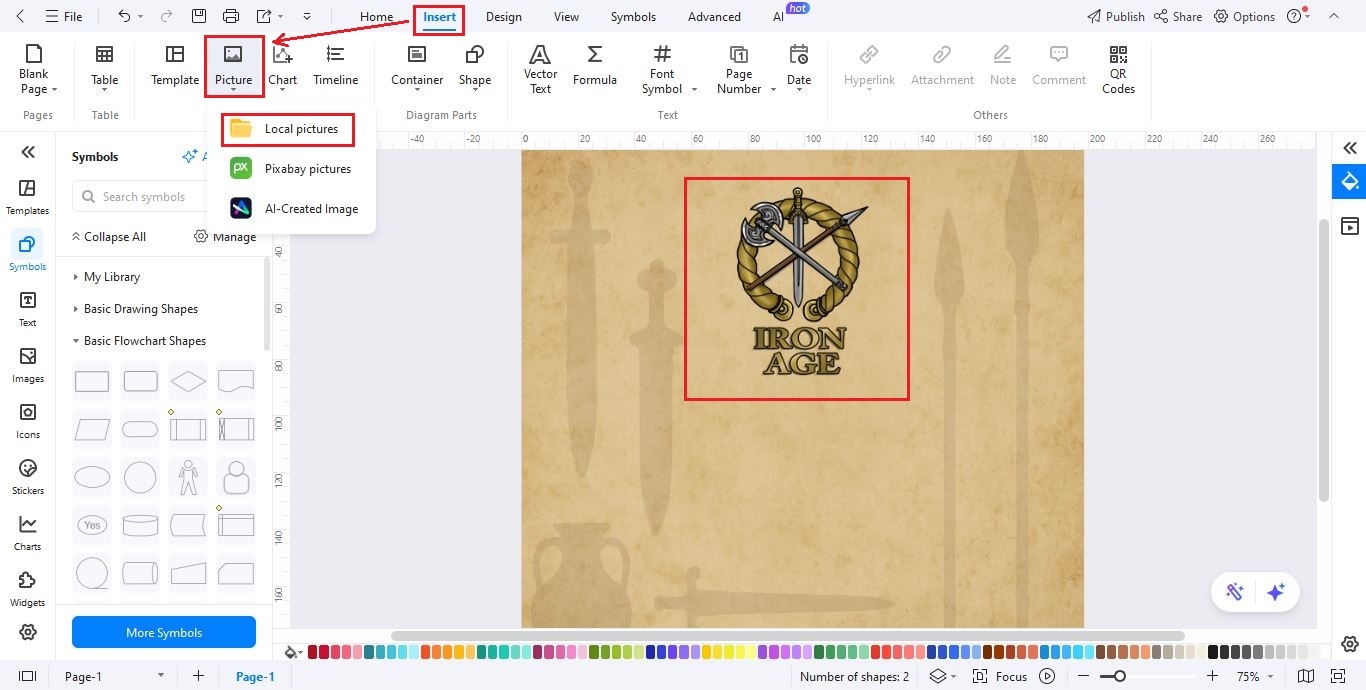
Step4Insert the Timeline Layout
- Now, let’s build the structure for the Iron Age events.
- Click Insert in the top menu.
- Select Timeline and scroll down.
- Choose Vertical Timeline, and pick the 4th option, which includes images.
- Click OK to add it to your canvas.
- Click the timeline, and a toolbar will appear. Personalize the timeline structure and style.
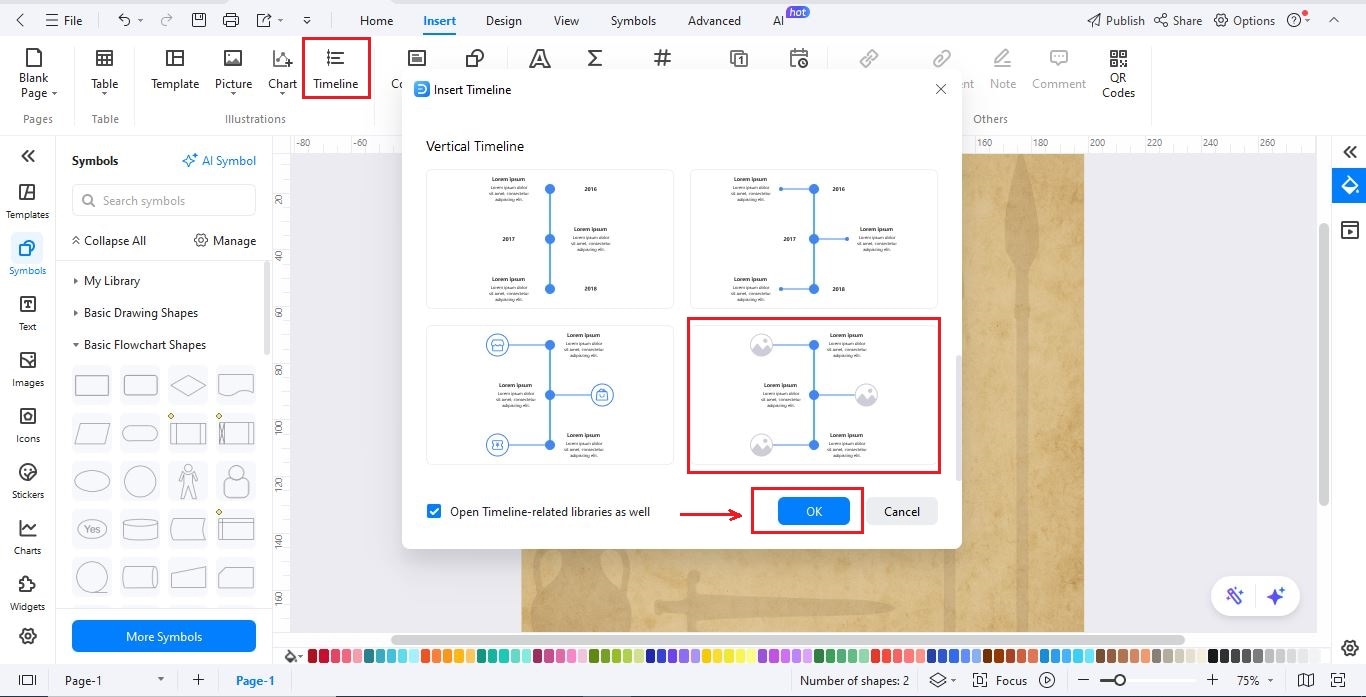
Step5Add Text to the Timeline
- Fill in the key historical stages of the Iron Age.
- On the left editing panel, click Text.
- Use Click to Add Subtitle for the year or century.
- Use Click to Add Body for a short description of events.
- Continue adding events through different regions and cultural developments of the Iron Age.
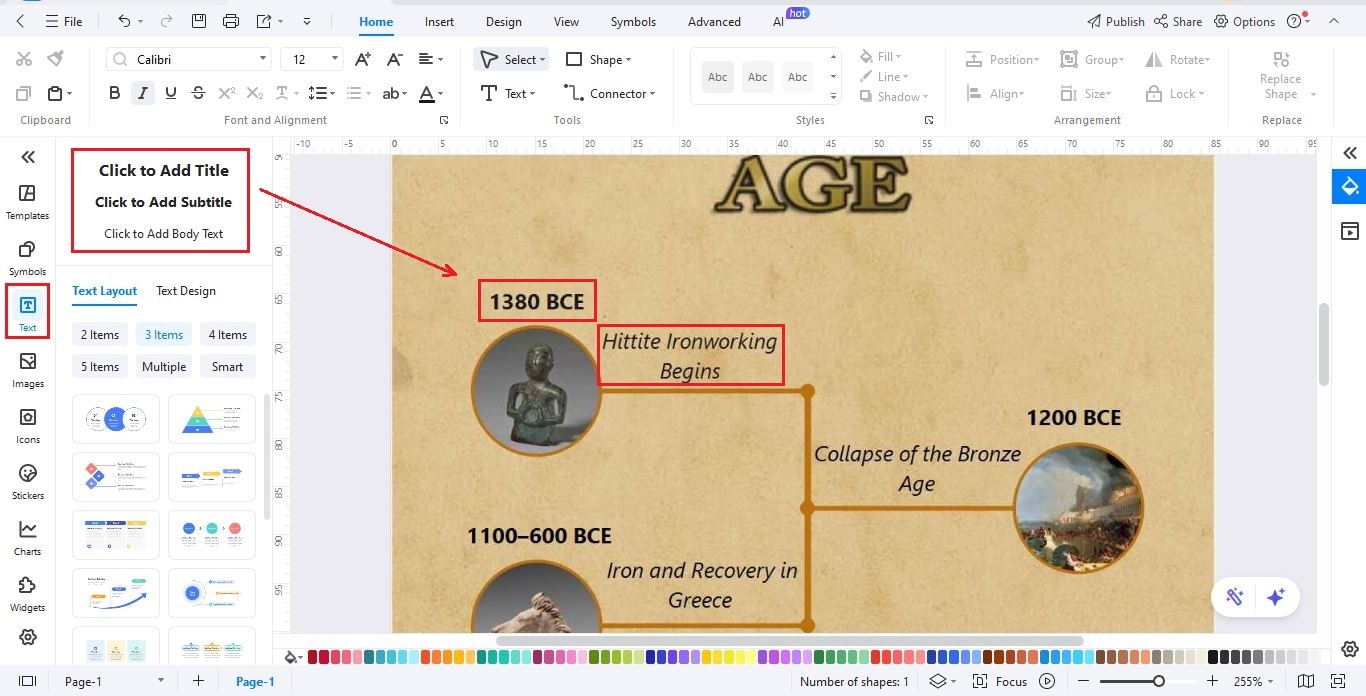
Step6Insert Thumbnail Images
- Make the timeline visually engaging with event-specific images.
- Go to Insert > Picture > Local Pictures and upload images (iron swords, farming tools, settlements, pottery, etc.).
- Use Crop to Shape to style the thumbnails into circles or decorative frames.
- Add an image for each milestone.
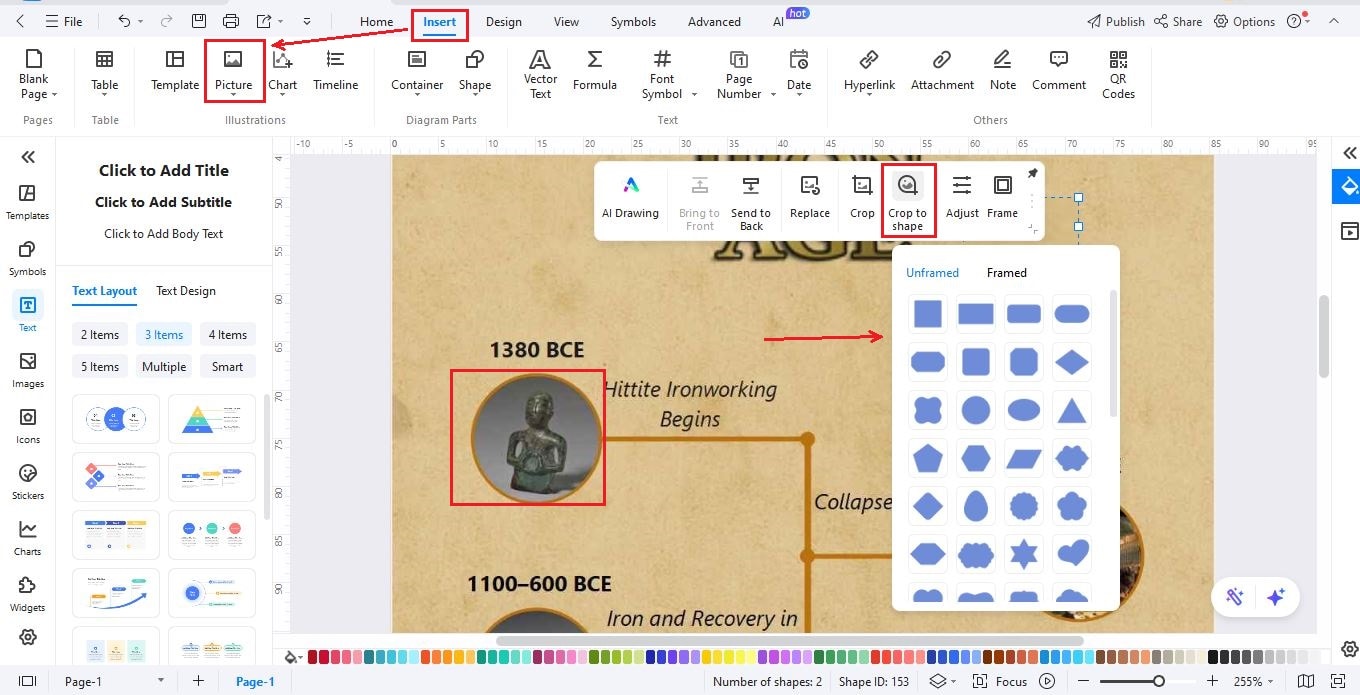
Step7Save, Share, or Export
- From the File menu, click Save to store an editable version.
- Click Share (top-right) to send it directly to others.
- To export, go to File > Export and choose PNG, PDF, SVG, HTML, Visio, or Excel.
- Click Publish to share your Iron Age timeline with the EdrawMax community for others to view.
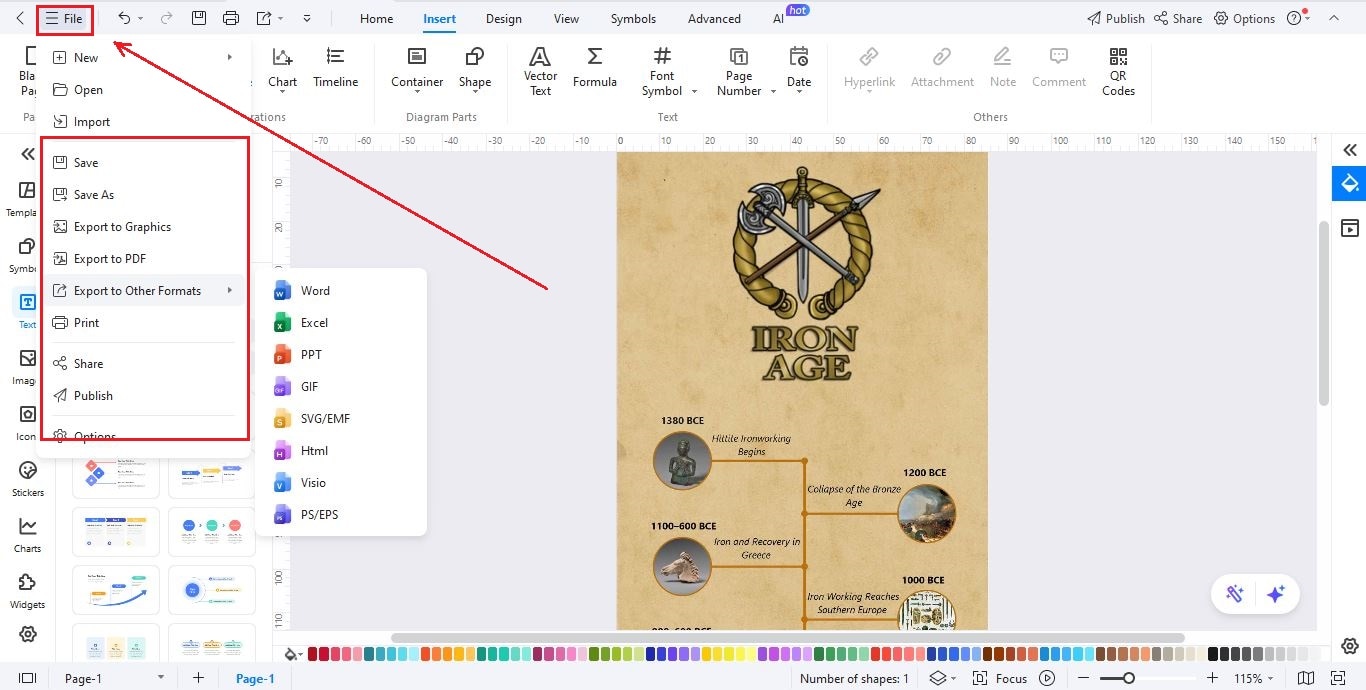
Final Thoughts
In the end, the Iron Age reminds us how progress comes from discovery and effort. Iron gave people tools to improve farming, craft better weapons, and build bigger societies. This period laid the groundwork for much of what followed in human history.
If you’re curious about history and want to share its stories or want to create an iron age timeline, try EdrawMax. It’s easy to use and perfect for learners and educators alike. So, give it a try, and bring your history projects to life with visuals that really connect.




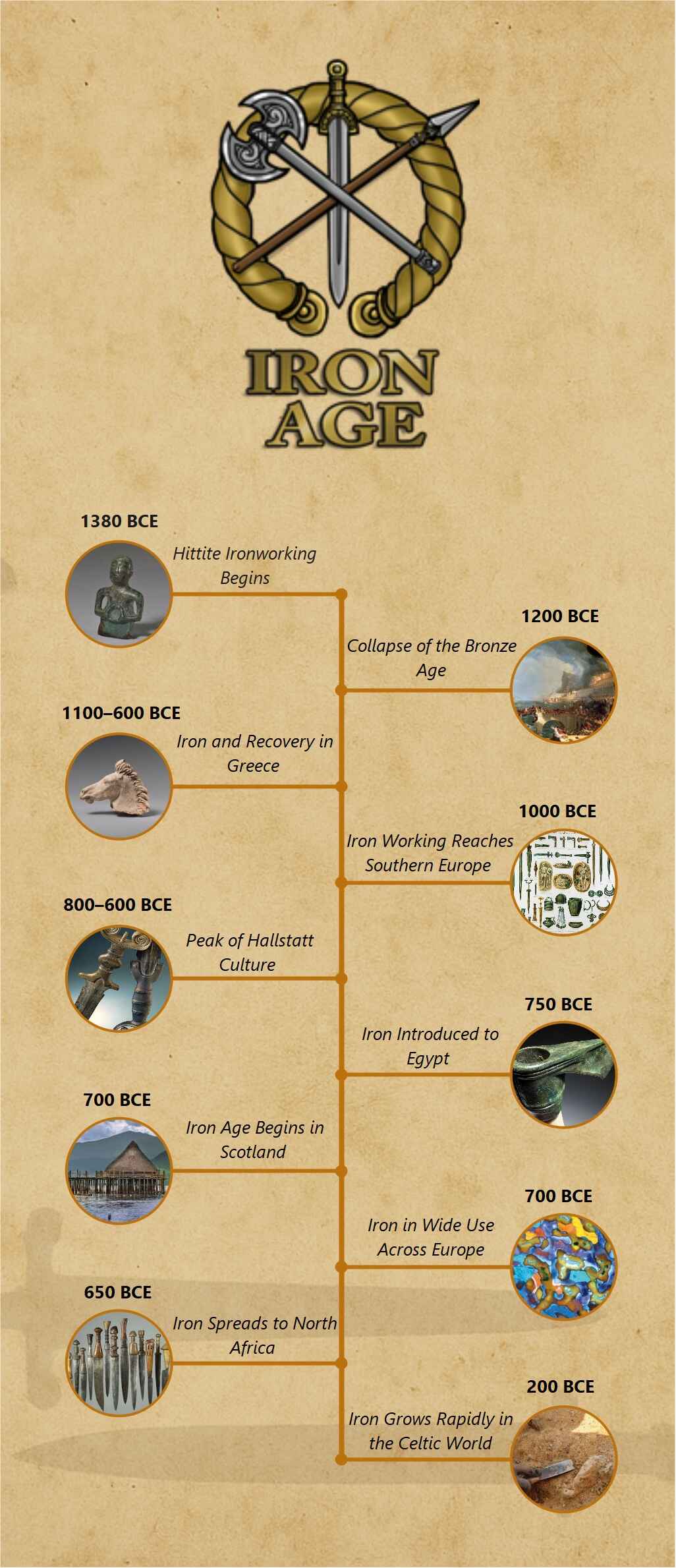
 below.
below.  below.
below. 